Analyzing the EYFS Framework: School Readiness & Child Assessment
VerifiedAdded on 2023/06/10
|9
|2263
|317
Essay
AI Summary
This essay provides a comprehensive assessment of children's learning and development within the Early Years Foundation Stage (EYFS) framework, focusing on its relevance to school readiness. It identifies key areas of learning, including communication and language, physical development, personal, social, and emotional development, literacy, mathematics, understanding the world, and expressive arts and design. The essay also examines assessment strategies within the EYFS framework, highlighting the importance of early learning goals and the Early Years Foundation Stage Profile. Furthermore, it evaluates the framework's effectiveness in supporting children's preparation for school, considering factors such as staff experience, parental involvement, and the challenges of assessing diverse learning paces. The essay concludes by emphasizing the need for tailored support and effective communication between educators, parents, and other professionals to ensure successful transitions for all children.
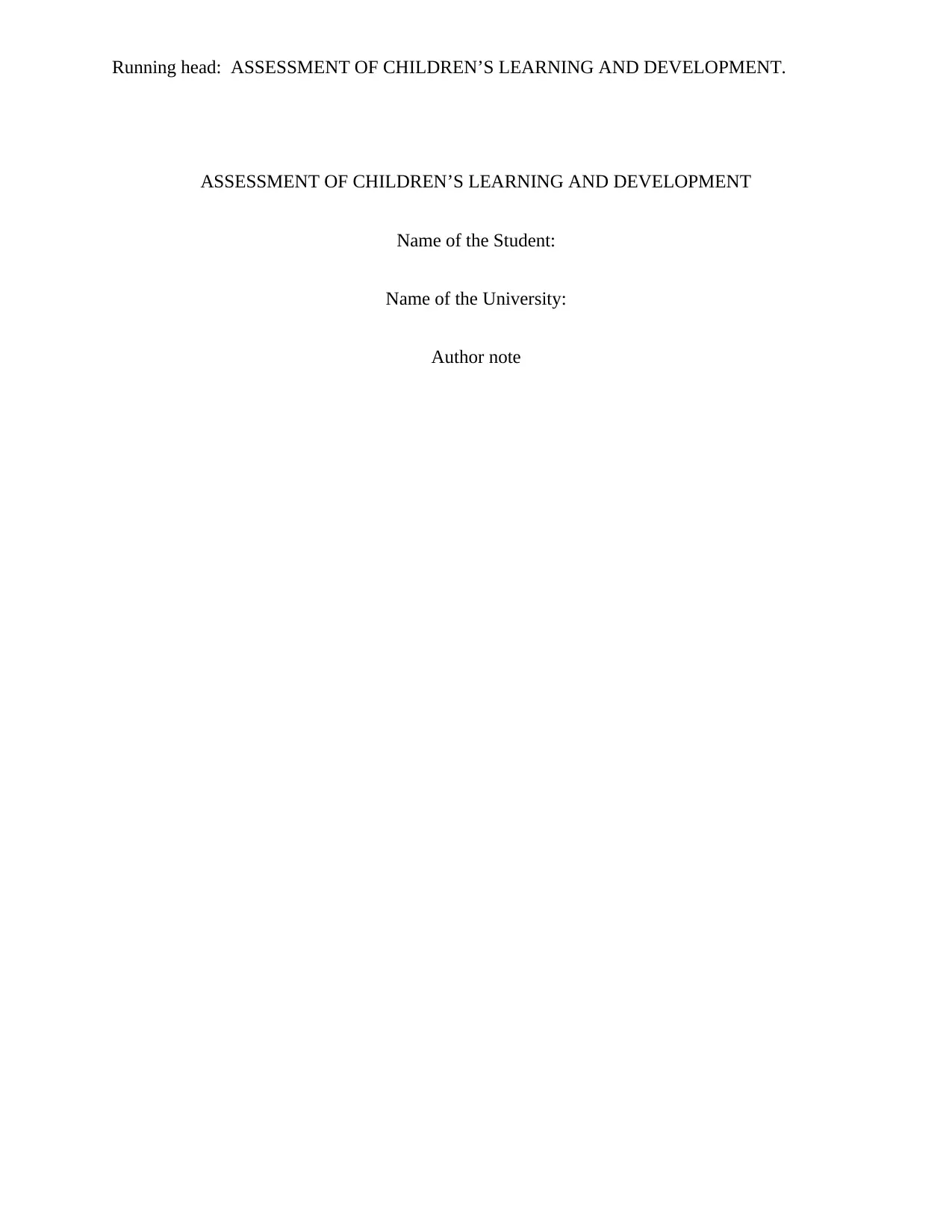
Running head: ASSESSMENT OF CHILDREN’S LEARNING AND DEVELOPMENT.
ASSESSMENT OF CHILDREN’S LEARNING AND DEVELOPMENT
Name of the Student:
Name of the University:
Author note
ASSESSMENT OF CHILDREN’S LEARNING AND DEVELOPMENT
Name of the Student:
Name of the University:
Author note
Paraphrase This Document
Need a fresh take? Get an instant paraphrase of this document with our AI Paraphraser
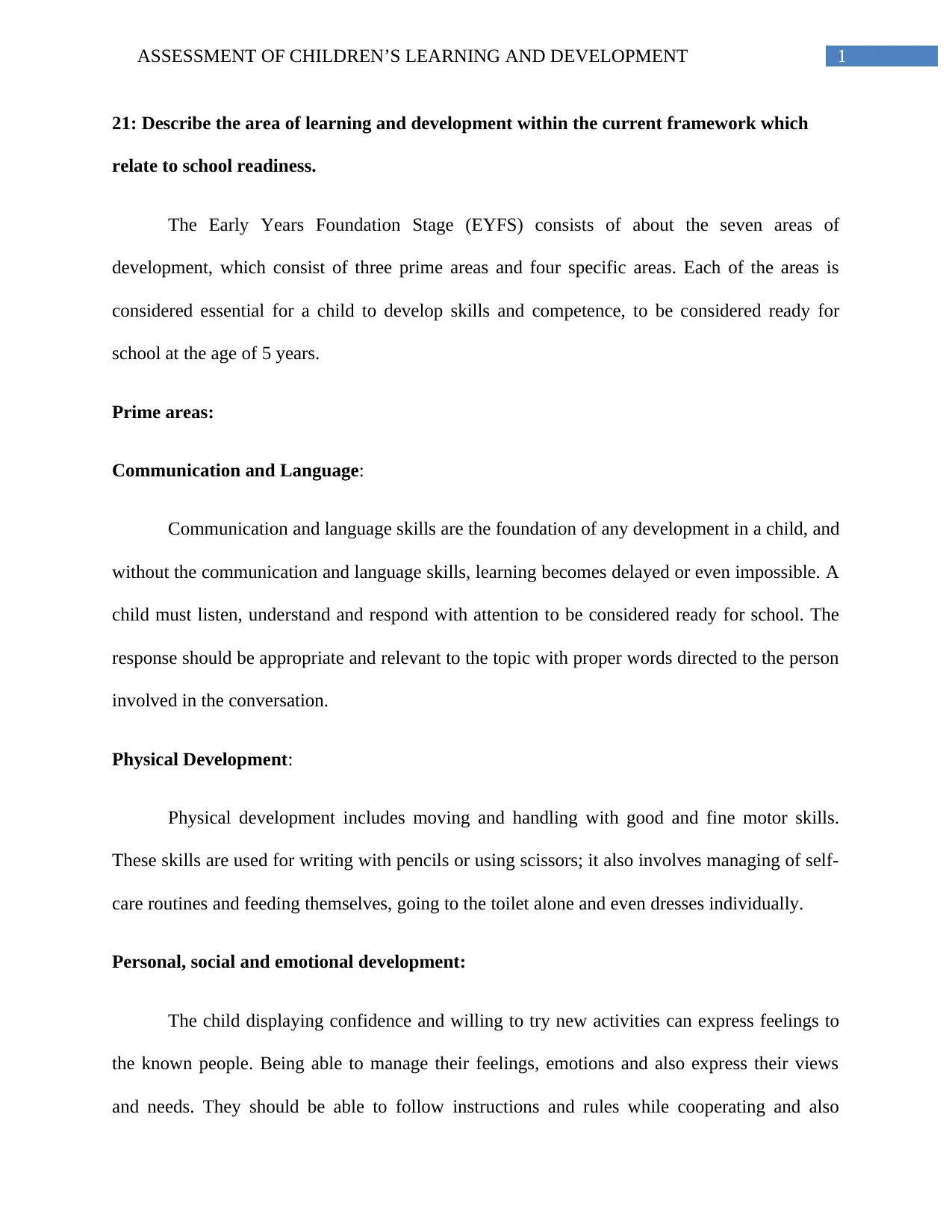
1ASSESSMENT OF CHILDREN’S LEARNING AND DEVELOPMENT
21: Describe the area of learning and development within the current framework which
relate to school readiness.
The Early Years Foundation Stage (EYFS) consists of about the seven areas of
development, which consist of three prime areas and four specific areas. Each of the areas is
considered essential for a child to develop skills and competence, to be considered ready for
school at the age of 5 years.
Prime areas:
Communication and Language:
Communication and language skills are the foundation of any development in a child, and
without the communication and language skills, learning becomes delayed or even impossible. A
child must listen, understand and respond with attention to be considered ready for school. The
response should be appropriate and relevant to the topic with proper words directed to the person
involved in the conversation.
Physical Development:
Physical development includes moving and handling with good and fine motor skills.
These skills are used for writing with pencils or using scissors; it also involves managing of self-
care routines and feeding themselves, going to the toilet alone and even dresses individually.
Personal, social and emotional development:
The child displaying confidence and willing to try new activities can express feelings to
the known people. Being able to manage their feelings, emotions and also express their views
and needs. They should be able to follow instructions and rules while cooperating and also
21: Describe the area of learning and development within the current framework which
relate to school readiness.
The Early Years Foundation Stage (EYFS) consists of about the seven areas of
development, which consist of three prime areas and four specific areas. Each of the areas is
considered essential for a child to develop skills and competence, to be considered ready for
school at the age of 5 years.
Prime areas:
Communication and Language:
Communication and language skills are the foundation of any development in a child, and
without the communication and language skills, learning becomes delayed or even impossible. A
child must listen, understand and respond with attention to be considered ready for school. The
response should be appropriate and relevant to the topic with proper words directed to the person
involved in the conversation.
Physical Development:
Physical development includes moving and handling with good and fine motor skills.
These skills are used for writing with pencils or using scissors; it also involves managing of self-
care routines and feeding themselves, going to the toilet alone and even dresses individually.
Personal, social and emotional development:
The child displaying confidence and willing to try new activities can express feelings to
the known people. Being able to manage their feelings, emotions and also express their views
and needs. They should be able to follow instructions and rules while cooperating and also
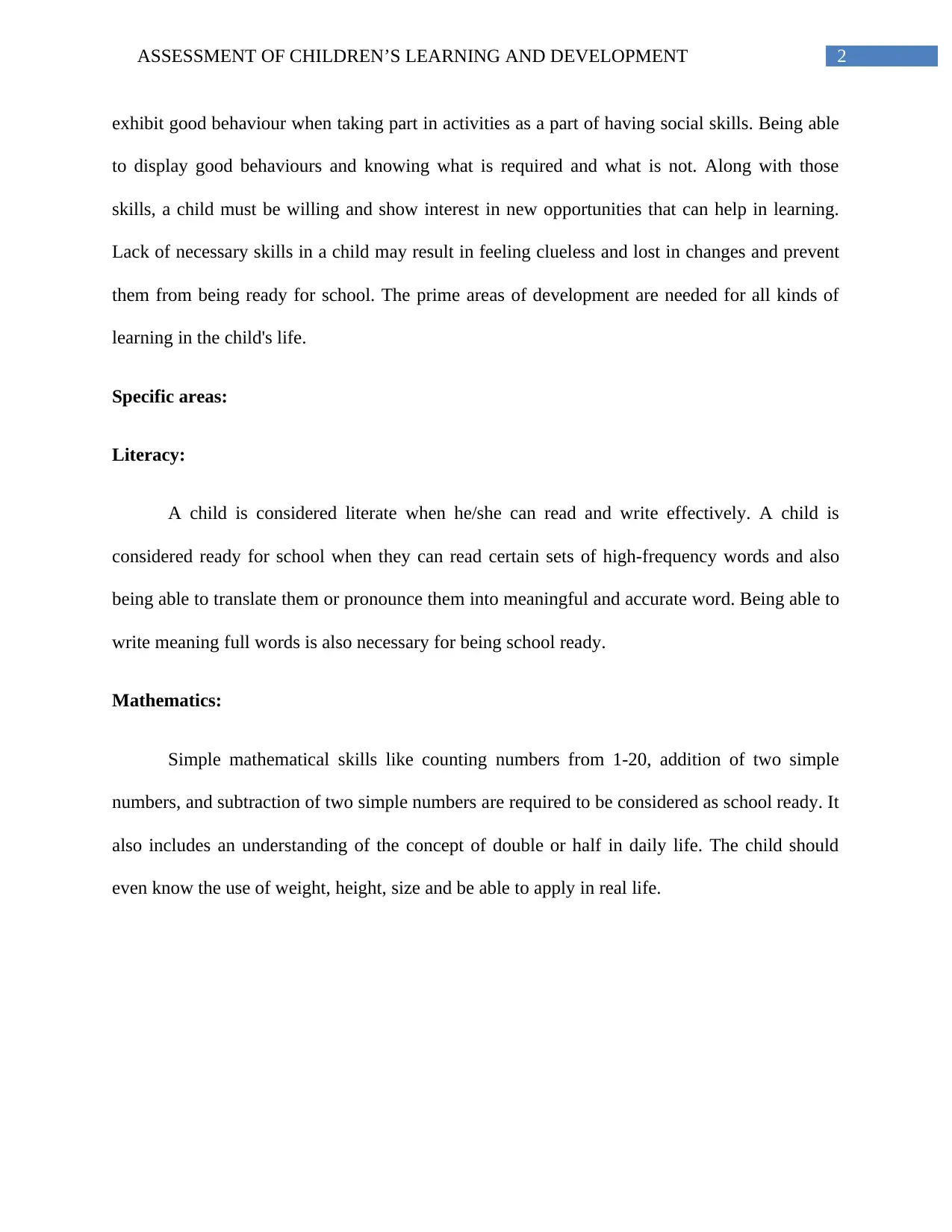
2ASSESSMENT OF CHILDREN’S LEARNING AND DEVELOPMENT
exhibit good behaviour when taking part in activities as a part of having social skills. Being able
to display good behaviours and knowing what is required and what is not. Along with those
skills, a child must be willing and show interest in new opportunities that can help in learning.
Lack of necessary skills in a child may result in feeling clueless and lost in changes and prevent
them from being ready for school. The prime areas of development are needed for all kinds of
learning in the child's life.
Specific areas:
Literacy:
A child is considered literate when he/she can read and write effectively. A child is
considered ready for school when they can read certain sets of high-frequency words and also
being able to translate them or pronounce them into meaningful and accurate word. Being able to
write meaning full words is also necessary for being school ready.
Mathematics:
Simple mathematical skills like counting numbers from 1-20, addition of two simple
numbers, and subtraction of two simple numbers are required to be considered as school ready. It
also includes an understanding of the concept of double or half in daily life. The child should
even know the use of weight, height, size and be able to apply in real life.
exhibit good behaviour when taking part in activities as a part of having social skills. Being able
to display good behaviours and knowing what is required and what is not. Along with those
skills, a child must be willing and show interest in new opportunities that can help in learning.
Lack of necessary skills in a child may result in feeling clueless and lost in changes and prevent
them from being ready for school. The prime areas of development are needed for all kinds of
learning in the child's life.
Specific areas:
Literacy:
A child is considered literate when he/she can read and write effectively. A child is
considered ready for school when they can read certain sets of high-frequency words and also
being able to translate them or pronounce them into meaningful and accurate word. Being able to
write meaning full words is also necessary for being school ready.
Mathematics:
Simple mathematical skills like counting numbers from 1-20, addition of two simple
numbers, and subtraction of two simple numbers are required to be considered as school ready. It
also includes an understanding of the concept of double or half in daily life. The child should
even know the use of weight, height, size and be able to apply in real life.
⊘ This is a preview!⊘
Do you want full access?
Subscribe today to unlock all pages.

Trusted by 1+ million students worldwide
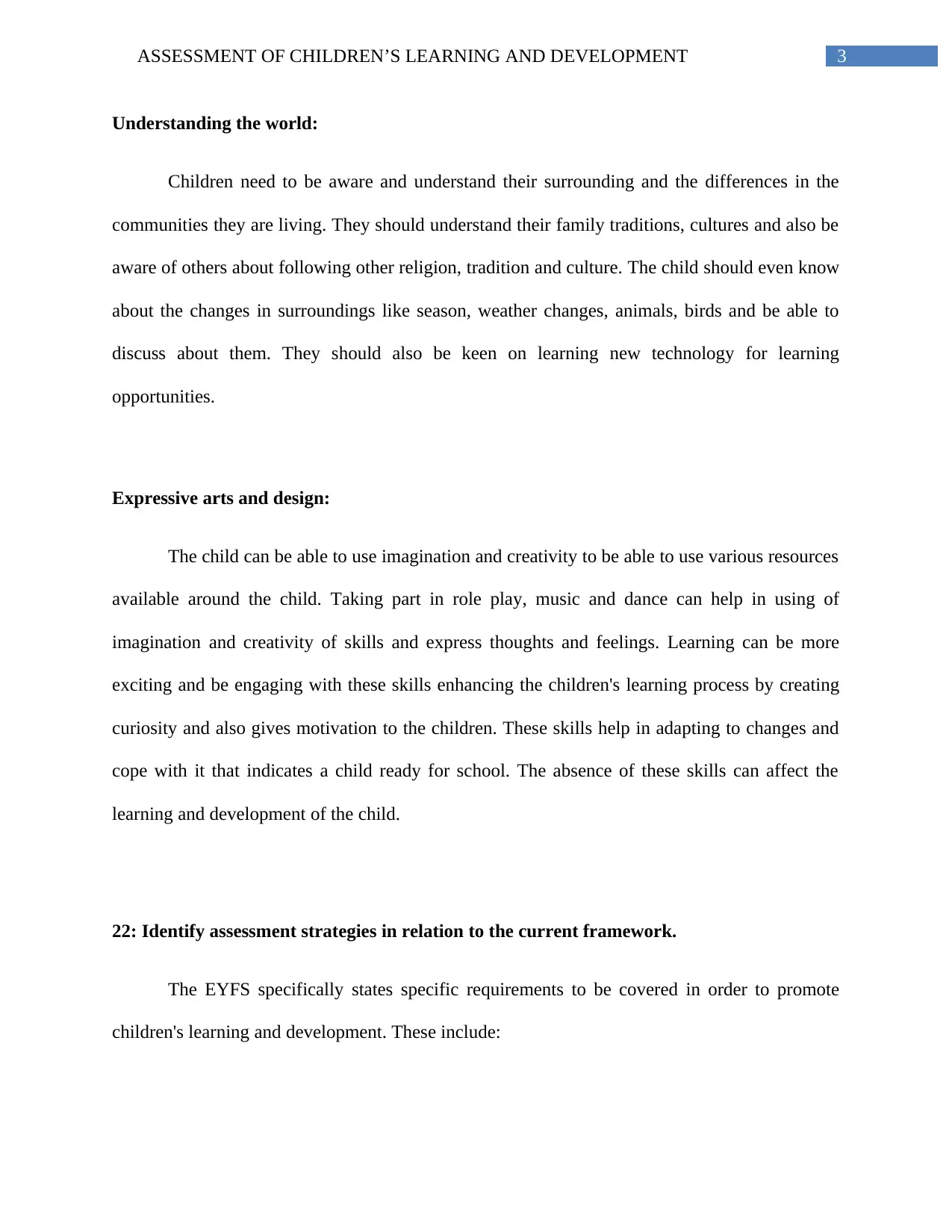
3ASSESSMENT OF CHILDREN’S LEARNING AND DEVELOPMENT
Understanding the world:
Children need to be aware and understand their surrounding and the differences in the
communities they are living. They should understand their family traditions, cultures and also be
aware of others about following other religion, tradition and culture. The child should even know
about the changes in surroundings like season, weather changes, animals, birds and be able to
discuss about them. They should also be keen on learning new technology for learning
opportunities.
Expressive arts and design:
The child can be able to use imagination and creativity to be able to use various resources
available around the child. Taking part in role play, music and dance can help in using of
imagination and creativity of skills and express thoughts and feelings. Learning can be more
exciting and be engaging with these skills enhancing the children's learning process by creating
curiosity and also gives motivation to the children. These skills help in adapting to changes and
cope with it that indicates a child ready for school. The absence of these skills can affect the
learning and development of the child.
22: Identify assessment strategies in relation to the current framework.
The EYFS specifically states specific requirements to be covered in order to promote
children's learning and development. These include:
Understanding the world:
Children need to be aware and understand their surrounding and the differences in the
communities they are living. They should understand their family traditions, cultures and also be
aware of others about following other religion, tradition and culture. The child should even know
about the changes in surroundings like season, weather changes, animals, birds and be able to
discuss about them. They should also be keen on learning new technology for learning
opportunities.
Expressive arts and design:
The child can be able to use imagination and creativity to be able to use various resources
available around the child. Taking part in role play, music and dance can help in using of
imagination and creativity of skills and express thoughts and feelings. Learning can be more
exciting and be engaging with these skills enhancing the children's learning process by creating
curiosity and also gives motivation to the children. These skills help in adapting to changes and
cope with it that indicates a child ready for school. The absence of these skills can affect the
learning and development of the child.
22: Identify assessment strategies in relation to the current framework.
The EYFS specifically states specific requirements to be covered in order to promote
children's learning and development. These include:
Paraphrase This Document
Need a fresh take? Get an instant paraphrase of this document with our AI Paraphraser
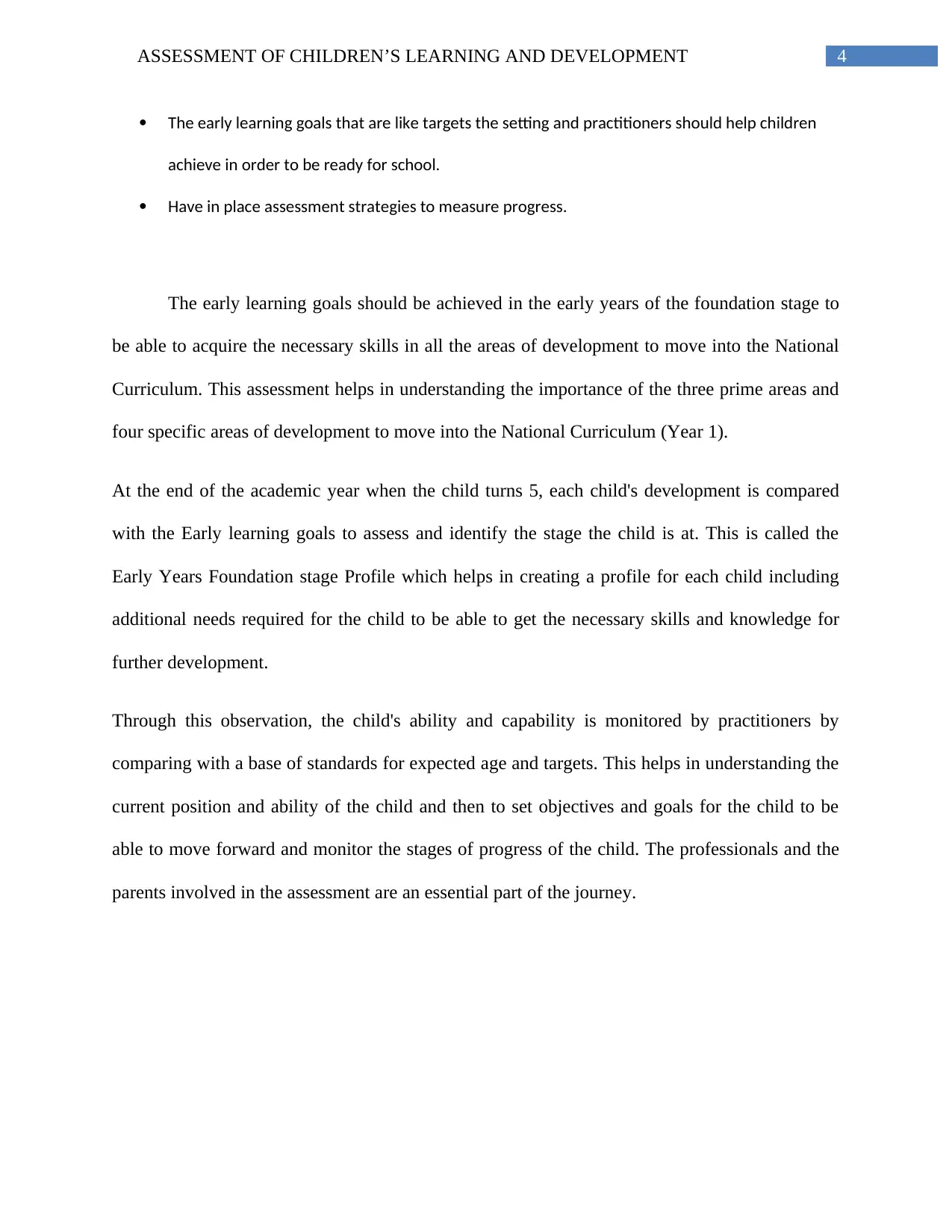
4ASSESSMENT OF CHILDREN’S LEARNING AND DEVELOPMENT
The early learning goals that are like targets the setting and practitioners should help children
achieve in order to be ready for school.
Have in place assessment strategies to measure progress.
The early learning goals should be achieved in the early years of the foundation stage to
be able to acquire the necessary skills in all the areas of development to move into the National
Curriculum. This assessment helps in understanding the importance of the three prime areas and
four specific areas of development to move into the National Curriculum (Year 1).
At the end of the academic year when the child turns 5, each child's development is compared
with the Early learning goals to assess and identify the stage the child is at. This is called the
Early Years Foundation stage Profile which helps in creating a profile for each child including
additional needs required for the child to be able to get the necessary skills and knowledge for
further development.
Through this observation, the child's ability and capability is monitored by practitioners by
comparing with a base of standards for expected age and targets. This helps in understanding the
current position and ability of the child and then to set objectives and goals for the child to be
able to move forward and monitor the stages of progress of the child. The professionals and the
parents involved in the assessment are an essential part of the journey.
The early learning goals that are like targets the setting and practitioners should help children
achieve in order to be ready for school.
Have in place assessment strategies to measure progress.
The early learning goals should be achieved in the early years of the foundation stage to
be able to acquire the necessary skills in all the areas of development to move into the National
Curriculum. This assessment helps in understanding the importance of the three prime areas and
four specific areas of development to move into the National Curriculum (Year 1).
At the end of the academic year when the child turns 5, each child's development is compared
with the Early learning goals to assess and identify the stage the child is at. This is called the
Early Years Foundation stage Profile which helps in creating a profile for each child including
additional needs required for the child to be able to get the necessary skills and knowledge for
further development.
Through this observation, the child's ability and capability is monitored by practitioners by
comparing with a base of standards for expected age and targets. This helps in understanding the
current position and ability of the child and then to set objectives and goals for the child to be
able to move forward and monitor the stages of progress of the child. The professionals and the
parents involved in the assessment are an essential part of the journey.
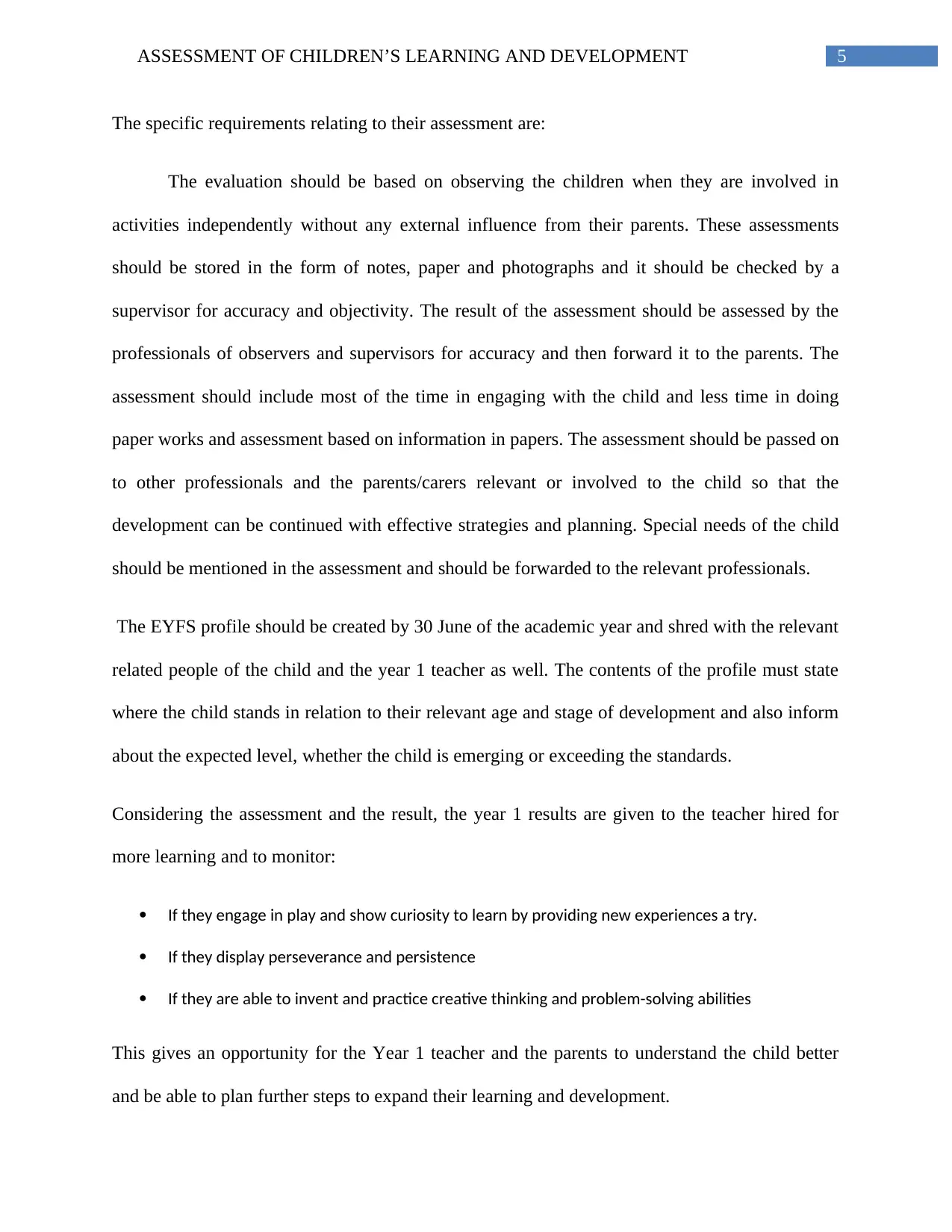
5ASSESSMENT OF CHILDREN’S LEARNING AND DEVELOPMENT
The specific requirements relating to their assessment are:
The evaluation should be based on observing the children when they are involved in
activities independently without any external influence from their parents. These assessments
should be stored in the form of notes, paper and photographs and it should be checked by a
supervisor for accuracy and objectivity. The result of the assessment should be assessed by the
professionals of observers and supervisors for accuracy and then forward it to the parents. The
assessment should include most of the time in engaging with the child and less time in doing
paper works and assessment based on information in papers. The assessment should be passed on
to other professionals and the parents/carers relevant or involved to the child so that the
development can be continued with effective strategies and planning. Special needs of the child
should be mentioned in the assessment and should be forwarded to the relevant professionals.
The EYFS profile should be created by 30 June of the academic year and shred with the relevant
related people of the child and the year 1 teacher as well. The contents of the profile must state
where the child stands in relation to their relevant age and stage of development and also inform
about the expected level, whether the child is emerging or exceeding the standards.
Considering the assessment and the result, the year 1 results are given to the teacher hired for
more learning and to monitor:
If they engage in play and show curiosity to learn by providing new experiences a try.
If they display perseverance and persistence
If they are able to invent and practice creative thinking and problem-solving abilities
This gives an opportunity for the Year 1 teacher and the parents to understand the child better
and be able to plan further steps to expand their learning and development.
The specific requirements relating to their assessment are:
The evaluation should be based on observing the children when they are involved in
activities independently without any external influence from their parents. These assessments
should be stored in the form of notes, paper and photographs and it should be checked by a
supervisor for accuracy and objectivity. The result of the assessment should be assessed by the
professionals of observers and supervisors for accuracy and then forward it to the parents. The
assessment should include most of the time in engaging with the child and less time in doing
paper works and assessment based on information in papers. The assessment should be passed on
to other professionals and the parents/carers relevant or involved to the child so that the
development can be continued with effective strategies and planning. Special needs of the child
should be mentioned in the assessment and should be forwarded to the relevant professionals.
The EYFS profile should be created by 30 June of the academic year and shred with the relevant
related people of the child and the year 1 teacher as well. The contents of the profile must state
where the child stands in relation to their relevant age and stage of development and also inform
about the expected level, whether the child is emerging or exceeding the standards.
Considering the assessment and the result, the year 1 results are given to the teacher hired for
more learning and to monitor:
If they engage in play and show curiosity to learn by providing new experiences a try.
If they display perseverance and persistence
If they are able to invent and practice creative thinking and problem-solving abilities
This gives an opportunity for the Year 1 teacher and the parents to understand the child better
and be able to plan further steps to expand their learning and development.
⊘ This is a preview!⊘
Do you want full access?
Subscribe today to unlock all pages.

Trusted by 1+ million students worldwide
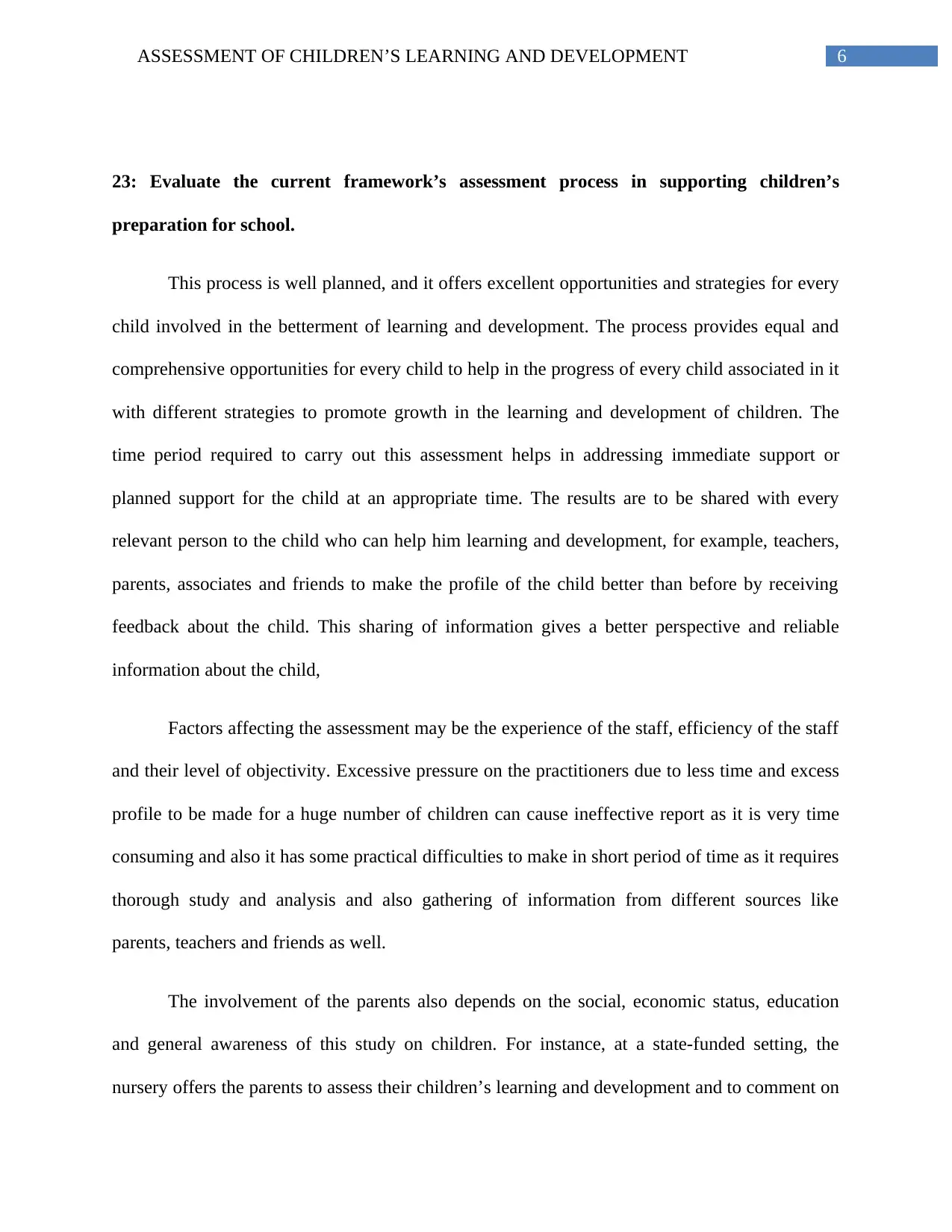
6ASSESSMENT OF CHILDREN’S LEARNING AND DEVELOPMENT
23: Evaluate the current framework’s assessment process in supporting children’s
preparation for school.
This process is well planned, and it offers excellent opportunities and strategies for every
child involved in the betterment of learning and development. The process provides equal and
comprehensive opportunities for every child to help in the progress of every child associated in it
with different strategies to promote growth in the learning and development of children. The
time period required to carry out this assessment helps in addressing immediate support or
planned support for the child at an appropriate time. The results are to be shared with every
relevant person to the child who can help him learning and development, for example, teachers,
parents, associates and friends to make the profile of the child better than before by receiving
feedback about the child. This sharing of information gives a better perspective and reliable
information about the child,
Factors affecting the assessment may be the experience of the staff, efficiency of the staff
and their level of objectivity. Excessive pressure on the practitioners due to less time and excess
profile to be made for a huge number of children can cause ineffective report as it is very time
consuming and also it has some practical difficulties to make in short period of time as it requires
thorough study and analysis and also gathering of information from different sources like
parents, teachers and friends as well.
The involvement of the parents also depends on the social, economic status, education
and general awareness of this study on children. For instance, at a state-funded setting, the
nursery offers the parents to assess their children’s learning and development and to comment on
23: Evaluate the current framework’s assessment process in supporting children’s
preparation for school.
This process is well planned, and it offers excellent opportunities and strategies for every
child involved in the betterment of learning and development. The process provides equal and
comprehensive opportunities for every child to help in the progress of every child associated in it
with different strategies to promote growth in the learning and development of children. The
time period required to carry out this assessment helps in addressing immediate support or
planned support for the child at an appropriate time. The results are to be shared with every
relevant person to the child who can help him learning and development, for example, teachers,
parents, associates and friends to make the profile of the child better than before by receiving
feedback about the child. This sharing of information gives a better perspective and reliable
information about the child,
Factors affecting the assessment may be the experience of the staff, efficiency of the staff
and their level of objectivity. Excessive pressure on the practitioners due to less time and excess
profile to be made for a huge number of children can cause ineffective report as it is very time
consuming and also it has some practical difficulties to make in short period of time as it requires
thorough study and analysis and also gathering of information from different sources like
parents, teachers and friends as well.
The involvement of the parents also depends on the social, economic status, education
and general awareness of this study on children. For instance, at a state-funded setting, the
nursery offers the parents to assess their children’s learning and development and to comment on
Paraphrase This Document
Need a fresh take? Get an instant paraphrase of this document with our AI Paraphraser
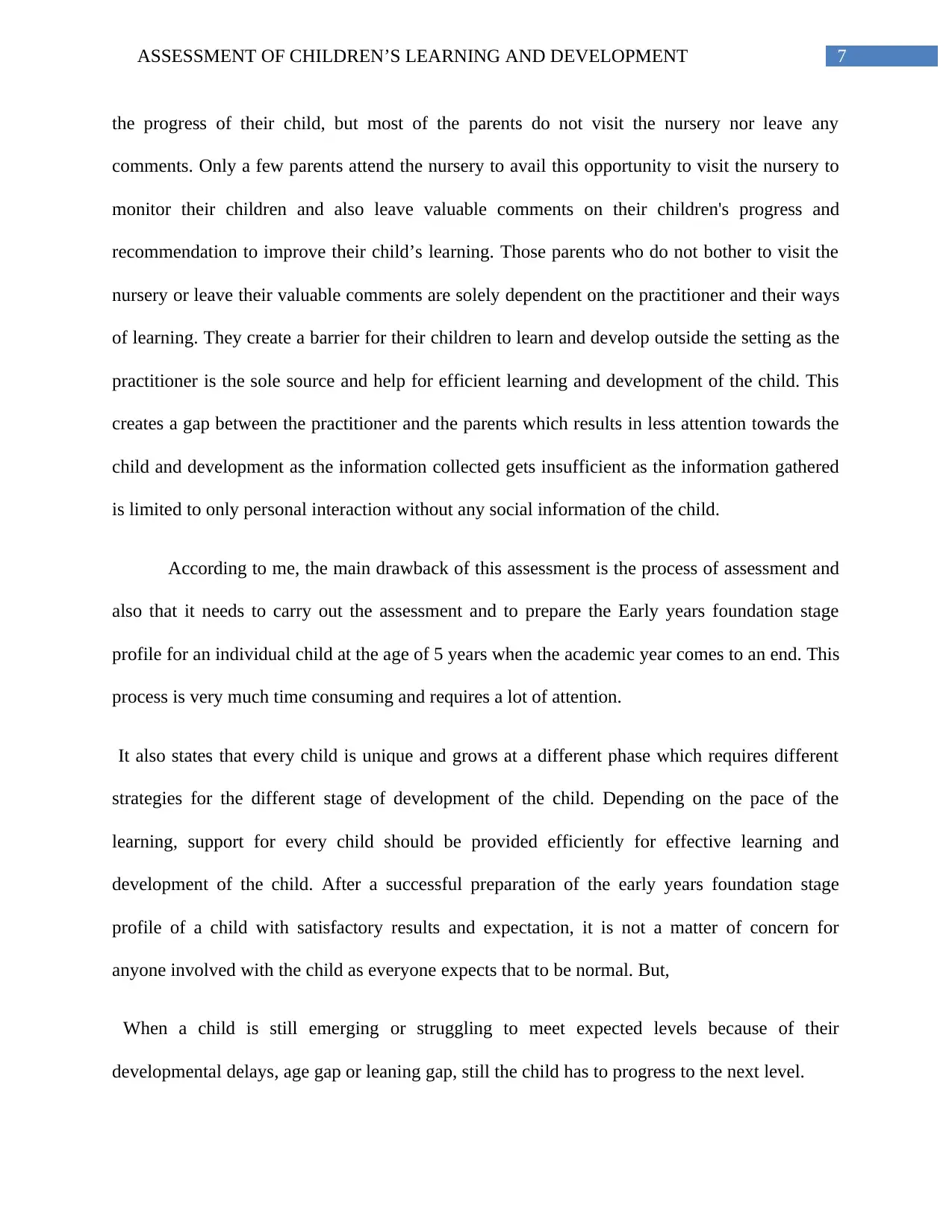
7ASSESSMENT OF CHILDREN’S LEARNING AND DEVELOPMENT
the progress of their child, but most of the parents do not visit the nursery nor leave any
comments. Only a few parents attend the nursery to avail this opportunity to visit the nursery to
monitor their children and also leave valuable comments on their children's progress and
recommendation to improve their child’s learning. Those parents who do not bother to visit the
nursery or leave their valuable comments are solely dependent on the practitioner and their ways
of learning. They create a barrier for their children to learn and develop outside the setting as the
practitioner is the sole source and help for efficient learning and development of the child. This
creates a gap between the practitioner and the parents which results in less attention towards the
child and development as the information collected gets insufficient as the information gathered
is limited to only personal interaction without any social information of the child.
According to me, the main drawback of this assessment is the process of assessment and
also that it needs to carry out the assessment and to prepare the Early years foundation stage
profile for an individual child at the age of 5 years when the academic year comes to an end. This
process is very much time consuming and requires a lot of attention.
It also states that every child is unique and grows at a different phase which requires different
strategies for the different stage of development of the child. Depending on the pace of the
learning, support for every child should be provided efficiently for effective learning and
development of the child. After a successful preparation of the early years foundation stage
profile of a child with satisfactory results and expectation, it is not a matter of concern for
anyone involved with the child as everyone expects that to be normal. But,
When a child is still emerging or struggling to meet expected levels because of their
developmental delays, age gap or leaning gap, still the child has to progress to the next level.
the progress of their child, but most of the parents do not visit the nursery nor leave any
comments. Only a few parents attend the nursery to avail this opportunity to visit the nursery to
monitor their children and also leave valuable comments on their children's progress and
recommendation to improve their child’s learning. Those parents who do not bother to visit the
nursery or leave their valuable comments are solely dependent on the practitioner and their ways
of learning. They create a barrier for their children to learn and develop outside the setting as the
practitioner is the sole source and help for efficient learning and development of the child. This
creates a gap between the practitioner and the parents which results in less attention towards the
child and development as the information collected gets insufficient as the information gathered
is limited to only personal interaction without any social information of the child.
According to me, the main drawback of this assessment is the process of assessment and
also that it needs to carry out the assessment and to prepare the Early years foundation stage
profile for an individual child at the age of 5 years when the academic year comes to an end. This
process is very much time consuming and requires a lot of attention.
It also states that every child is unique and grows at a different phase which requires different
strategies for the different stage of development of the child. Depending on the pace of the
learning, support for every child should be provided efficiently for effective learning and
development of the child. After a successful preparation of the early years foundation stage
profile of a child with satisfactory results and expectation, it is not a matter of concern for
anyone involved with the child as everyone expects that to be normal. But,
When a child is still emerging or struggling to meet expected levels because of their
developmental delays, age gap or leaning gap, still the child has to progress to the next level.
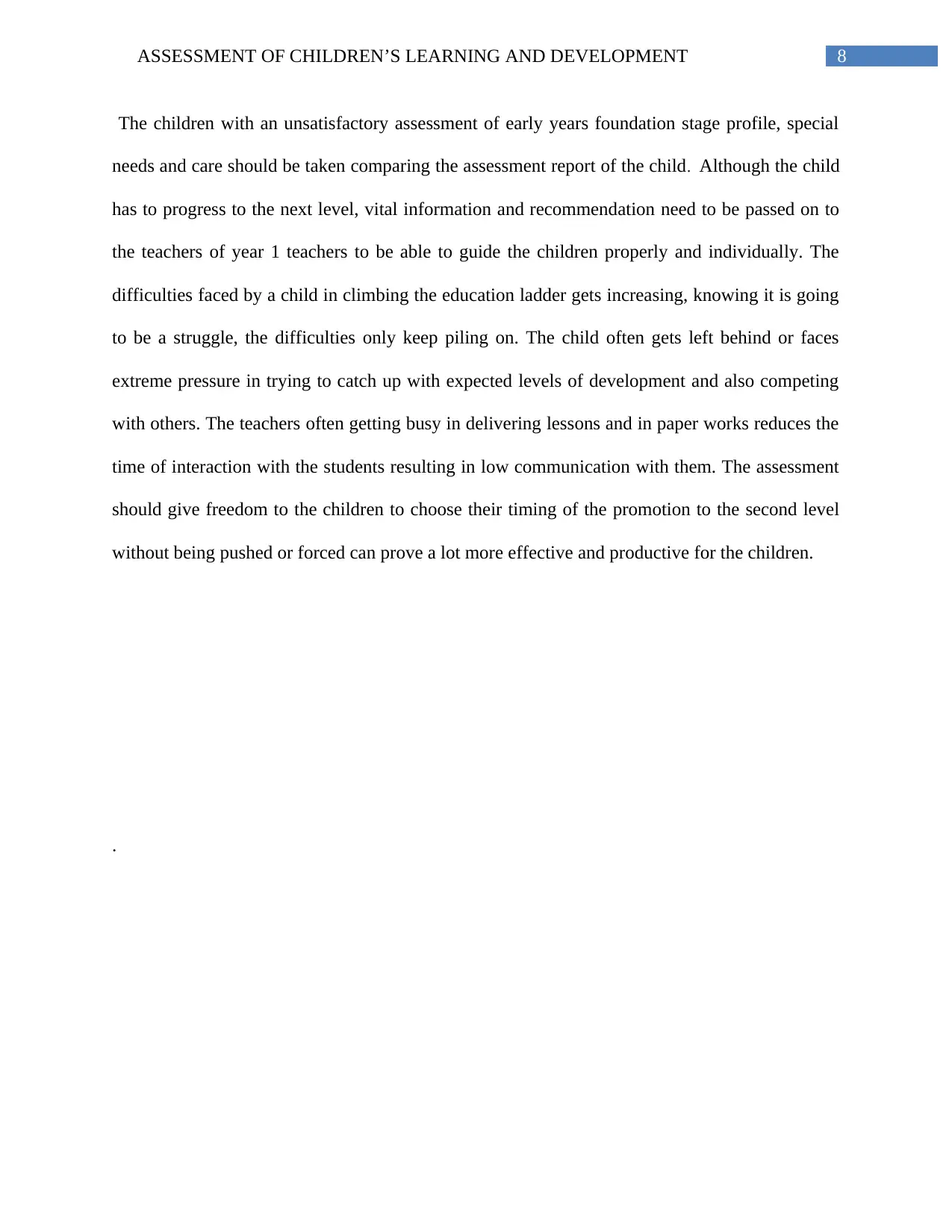
8ASSESSMENT OF CHILDREN’S LEARNING AND DEVELOPMENT
The children with an unsatisfactory assessment of early years foundation stage profile, special
needs and care should be taken comparing the assessment report of the child. Although the child
has to progress to the next level, vital information and recommendation need to be passed on to
the teachers of year 1 teachers to be able to guide the children properly and individually. The
difficulties faced by a child in climbing the education ladder gets increasing, knowing it is going
to be a struggle, the difficulties only keep piling on. The child often gets left behind or faces
extreme pressure in trying to catch up with expected levels of development and also competing
with others. The teachers often getting busy in delivering lessons and in paper works reduces the
time of interaction with the students resulting in low communication with them. The assessment
should give freedom to the children to choose their timing of the promotion to the second level
without being pushed or forced can prove a lot more effective and productive for the children.
.
The children with an unsatisfactory assessment of early years foundation stage profile, special
needs and care should be taken comparing the assessment report of the child. Although the child
has to progress to the next level, vital information and recommendation need to be passed on to
the teachers of year 1 teachers to be able to guide the children properly and individually. The
difficulties faced by a child in climbing the education ladder gets increasing, knowing it is going
to be a struggle, the difficulties only keep piling on. The child often gets left behind or faces
extreme pressure in trying to catch up with expected levels of development and also competing
with others. The teachers often getting busy in delivering lessons and in paper works reduces the
time of interaction with the students resulting in low communication with them. The assessment
should give freedom to the children to choose their timing of the promotion to the second level
without being pushed or forced can prove a lot more effective and productive for the children.
.
⊘ This is a preview!⊘
Do you want full access?
Subscribe today to unlock all pages.

Trusted by 1+ million students worldwide
1 out of 9
Related Documents
Your All-in-One AI-Powered Toolkit for Academic Success.
+13062052269
info@desklib.com
Available 24*7 on WhatsApp / Email
![[object Object]](/_next/static/media/star-bottom.7253800d.svg)
Unlock your academic potential
Copyright © 2020–2025 A2Z Services. All Rights Reserved. Developed and managed by ZUCOL.




